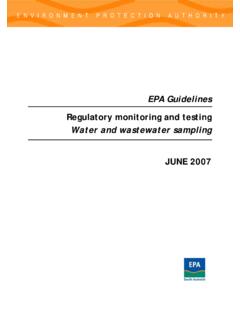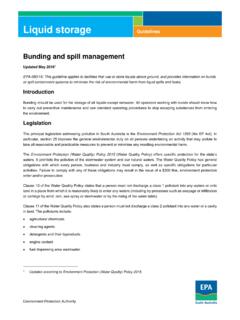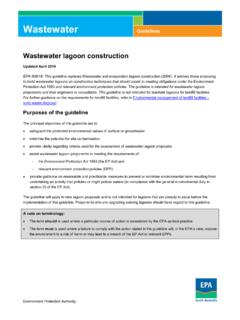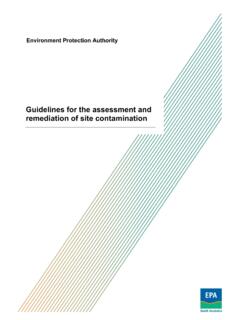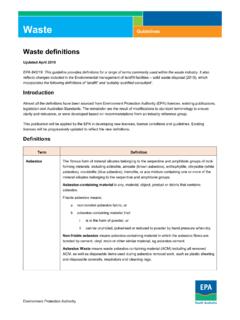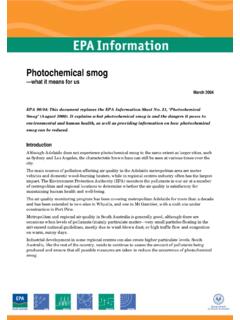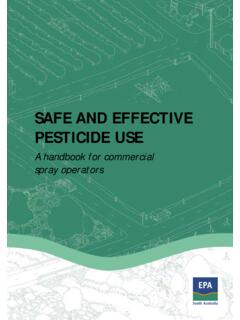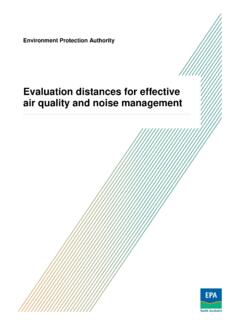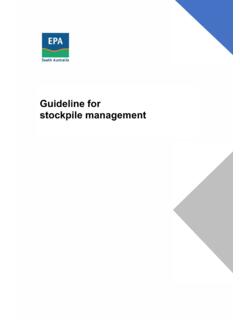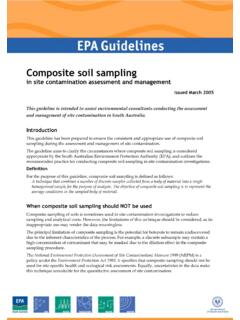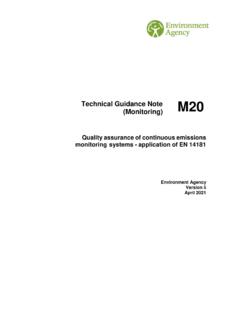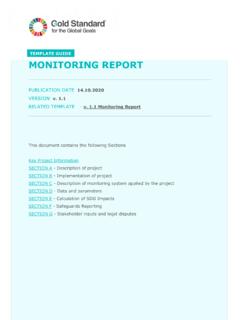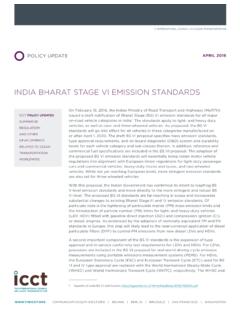Transcription of Emission testing methodology for air pollution
1 Environment Protection Authority Emission testing methodology for Air pollution Version 2, August 2012 Emission testing methodology for Air pollution , Version 2, August 2012 Issued by the Environment Protection Authority For further information please contact: Information Officer Environment Protection Authority GPO Box 2607 Adelaide SA 5001 Telephone: (08) 8204 2004 Facsimile: (08) 8124 4670 Free call (country): 1800 623 445 Website: < > Email: ISBN 978-1-921495-28-1 Issued March 1995 Updated August 2012 Environment Protection Authority This document may be reproduced in whole or part for the purpose of study or training, subject to the inclusion of an acknowledgment of the source and to it not being used for commercial purposes or sale.
2 Reproduction for purposes other than those given above requires the prior written permission of the Environment Protection Authority. Printed on recycled paper Contents 1 Introduction ..1 2 Stack 3 Assessment process for new test methods or technologies ..26 Appendix A Test method assessment process ..27 Appendix B Quality assurance/quality control requirements ..32 Appendix C Definitions for the purpose of this document ..35 Appendix D Referenced South Australian Environment Protection Authority Methods.
3 36 Acknowledgments ..124 List of tables Table Sources of test methods and their associated Table Approved manual sampling and analysis test methods for stack Table Approved continuous stack Emission monitoring test methods ..17 Table Compound Approved Stack Test Methods ..19 Emission testing methodology for Air pollution 1 1 Introduction Air quality Air quality continues to be among the top environmental concerns for South Australians. Industry can use an air monitoring program to assist in addressing its environmental responsibilities, and its responsibility as a local community member. Industry performance monitoring enables industrial plant to be managed in an environmentally sustainable manner, and to the requirements of the Environment Protection Act 1993 (EP Act) and the Environment Protection (Air Quality) Policy 1994 [Air Quality EPP].
4 In addition, the data can be useful in the design and implementation of clean technology systems and assist with identifying waste minimisation opportunities, leading to cost savings. Scope and purpose The primary purpose of industry performance monitoring is to provide information to the Environment Protection Authority (EPA) and licensees to compare emissions against relevant EPA standards and any requirements of an environmental authorisation. This manual applies to testing of chimney stack gas and particulate emissions for the EPA under Schedule 1 of the Air Quality EPP. Methods in this manual must be used for testing under this schedule. Any variation to the requirements of this methodology for this testing by the licensee must have prior written approval from the EPA.
5 The use of this manual is mandatory under section 4 part 6 of the Air Quality EPP. This manual also contains methods for testing of emissions not listed in Schedule 1. These methods should be used for Emission testing of additional pollutants should it be required under an environmental authorisation or environmental improvement plan. The manual provides a basis for a standardised approach to Emission testing in South Australia, incorporating relevant procedures, protocols, codes of practice, performance standards, Australian Standards and other methodology approved by the EPA. This manual will assist licensees, test laboratories and analytical laboratories to monitor and report on air quality in a consistent manner using approved methods.
6 This manual establishes approved practices and procedures, for sampling and analysing stack emissions . It is also designed to assist licensees, test laboratories and analytical laboratories with background information and guidance on performance monitoring for environmental purposes. Emission testing methodology for Air pollution 2 2 Stack emissions Introduction The following section includes information on: designing and planning a monitoring program stack Emission sampling health and safety precautions stack sampling for industrial activities. Planning a monitoring program The primary purpose of industry performance monitoring is to provide information to the EPA and licensees to compare emissions against relevant EPA standards and any requirements of an environmental authorisation.
7 In addition, the data can be useful in the design and implementation of clean technology systems, to assist in identifying waste minimisation opportunities and for process management and reporting. This will involve sampling from chimney stacks or other designated discharge points and determining the characteristics of the Emission gas stream. Performance or compliance monitoring must provide timely, reliable and accurate information, regarding the composition and rate of Emission of pollution to the environment. This will enable prompt action on any issues. Holders of EPA licences must ensure that the provisions of sampling, including sampling plane, access ports and work platforms meet the requirements specified in the relevant methods and standards and in this manual.
8 Safety is of prime importance. Reporting must be as detailed in the requirements of section Sampling of a pollution discharge must be undertaken at the frequency and locations specified in the license issued by the EPA. A detailed knowledge of the operation of the source(s) and any associated air pollution control devices is also important in obtaining a representative sample of the gas stream. The choice of measurement methods must be compatible with the objectives of the monitoring program and conditions of the EPA license. Stack Emission testing There is no single sampling method to cope with the variable and complex nature of source emissions . This section provides information on aspects of sampling that must be considered prior to embarking on a sampling program.
9 Staff of the testing laboratory and licensee are responsible to ensure the safety of all involved in testing . Should there be doubt about the safety of a given test situation then the test must be postponed until safety issues are resolved. Rescheduling will require consultation with the EPA for the required tests. When the monitoring is to be conducted on a site not under the control of the test laboratory, arrangements will need to be made with site management. All site safety procedures must be followed. If the test laboratory assesses that there is unacceptable risk involved in testing / monitoring , then site management and other relevant parties should be informed and monitoring must not proceed until the safety issues are resolved.
10 Emission testing methodology for Air pollution 3 The sample(s) analysed must be representative of the gas stream being tested. Therefore, the objective of the stack sampling technique is to ensure that the sampled gas stream is representative of either the total or a known portion of the source emissions . It is essential that test and analytical laboratory personnel are familiar and competent in individual methods. This facilitates the capture of accurate, representative samples and ensures sample handling and preservation requirements are met. Sampling, monitoring or field measurements must be undertaken within the framework of a well documented quality system. This applies whether the licence holder or the test laboratory is responsible for the sampling, or another organisation is contracted to conduct the tests.
